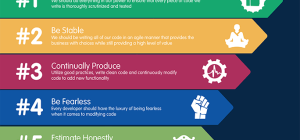 There are multiple steps to building a custom application software. Custom application development involves designing, deploying and maintaining revolutionary software products. Typically, custom app software development is performed by experienced, computer science experts. As a developer, you need to be familiar with the required software development steps to launch a new program. This way, you can implement development strategies that work for your project. Follow the steps below to learn how to build a custom application software.
There are multiple steps to building a custom application software. Custom application development involves designing, deploying and maintaining revolutionary software products. Typically, custom app software development is performed by experienced, computer science experts. As a developer, you need to be familiar with the required software development steps to launch a new program. This way, you can implement development strategies that work for your project. Follow the steps below to learn how to build a custom application software.
Define Software Solution
First, define your proposed solution to build a custom app software. Of course, you need to define the purpose of your intended software product. This way, you can appropriately determine the software use cases and key functionalities from the start. Typically, businesses develop custom software to improve flexibility, reduce operational expenses, and boost internal program efficiency. With a clear direction, you can solve problems, strengthen scalability and streamline organizational support. Furthermore, by setting business goals, objectives and advancements, you can track the project progress. This way, all development teams can collaborate towards a common goal. By defining your software solution, you can start to build a popular and well-powered custom application software.
Choose The Technology Stack
Next, choose the right technology stack when building a custom application software. Tech stacks include programming languages, tools and frameworks used to develop the software. There are four components to consider when choosing your stack: final product, development platforms, software maturity and talent pool. You want front-end development stack to include HTML, CSS and Javascript. Meanwhile, your backend tech stack should efficiently pass data from the server-side to the user-side. You can choose a stack that includes a DevOps Pipeline by JFrog. This solution offers continuous integration and delivery (CI,CD) to your software development lifecycle. Certainly choose the correct technology stack for your custom application software.
Develop Your Software
Of course, the next step is to develop your custom application software. Become a project manager to keep your engineering team organized and on schedule. Ensure you have software developers to write code, technical architects for framework design and designers for interface/user interactions. Plan the team’s work schedule and start the process. Begin with the software structure and framework. This determines which technologies are used and how they will work together. This section can take up to 2 weeks depending on the system complexity. Next, your team must start coding the project which can take up to 6 months or more. Certainly, schedule and develop your custom application software.
Prepare Software Documentation
Furthermore, document your custom software design and development process. Document what has been done, the technology used and the steps needed to complete the software. Additionally, documentation pinpoints sector responsibilities while addressing expectations and set dates. There are specific documents that can simplify the development process. Of course, have a test plan and checklist to ensure the project is completely vetted. Meanwhile, construct an implementation plan to define when the software can be used and by who. These permissions are helpful in mult-layered organizations. Definitely document your custom application software process as it can simplify production and deployment.
Conduct Thorough Software Testing
Finally, conduct testing to finalize the custom application software process. Of course, software tests are essential in improving quality. Once the product is developed, testing is done to locate and fix issues. You must test the core application functions, text input, multiple device compatibility and installation to optimize your software. If a bug is detected, the software should be fixed and run for testing again. Testing should be repeated until the software meets quality requirements. Conduct functional or non-functional testing to finalize your software. Functional testing involves testing software application functionalities. Different functional tests include unit testing, integration testing and regression testing. Meanwhile, non-functional testing inspects non-functional aspects including reliability, performance and security. These tests include load testing, failover testing and endurance testing. Certainly, test your custom application software to ensure usability.
Certainly, there are several steps to build a custom application software. First, define your software solution to determine the purpose of your custom app software. Next, choose the correct technology stack so your software is developed with the correct infrastructure. Of course, develop your software to have an app people can use. Ensure that you are working with a trusted development team including architects, developers and designers. Certainly document the development/deployment processes to track project responsibility, deadlines and requirements. Finally, test your software to ensure usability, reliability and quality. Testing your software can fix all issues, bugs and problems before deploying your program. Follow these steps to build a custom application software.







